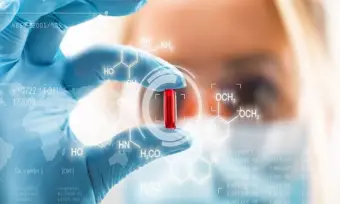Avatrombopag API Manufacturers & Suppliers
Find, compare & contact
Filters
Custom request?
Type
Production region
Qualifications
Country of origin
Produced in:
Established in: 2004
MOQ: -
Employees: 700+

has international standard facilities for API

specialized in active pharmaceutical ingredients development and GMP manufacturing

has 3 manufacturing plants
+ 0
All certificates
Distributor
Produced in:
Established in: 2011
MOQ: -
Employees: 25

Technical expertise ensuring optimal selection and development of APIs and intermediates

Globally connected with multiple GMP-compliant manufacturing facilities

Regulatory excellence with a dedicated team with global reach
+ 0
All certificates
How does it work?
You can register for free as long as you are registering on behalf of a legal company related to the pharmaceutical industry
Search in the search bar the product that you’re looking for. We’ll show you an overview of all available suppliers. Use the filters to select the relevant suppliers only
Have you found interesting suppliers? Then it’s time to contact them. Use the send inquiry button and send them a message. You can send for each product, 3 inquiries per week
Suppliers get notified by Pharmaoffer that they’ve received a new inquiry. They will come back to you with their questions, certificates, and offer in the chat on Pharmaoffer. We will send you an email in case of any news
Does the supplier meet your quality and commercial requirements? Then you can place the order. Just follow the steps of our order module
Looking for Avatrombopag API 570406-98-3?
- Description:
- Here you will find a list of producers, manufacturers and distributors of Avatrombopag. You can filter on certificates such as GMP, FDA, CEP, Written Confirmation and more. Send inquiries for free and get in direct contact with the supplier of your choice.
- API | Excipient name:
- Avatrombopag
- Synonyms:
- Cas Number:
- 570406-98-3
- DrugBank number:
- DB11995
- Unique Ingredient Identifier:
- 3H8GSZ4SQL
General Description:
Avatrombopag, identified by CAS number 570406-98-3, is a notable compound with significant therapeutic applications. Avatrombopag (_Doptelet_), is an orally administered, small-molecule thrombopoietin receptor (c-Mpl) agonist which increases platelet number, but not platelet activation , . This decreases the need for blood transfusions . Patients with thrombocytopenia and chronic liver disease (leading to thrombocytopenia) often require platelet transfusions before surgical procedures to decrease the risk of bleeding . Thrombocytopenia (or decreased numbers of platelets) is a common complication in patients suffering from chronic liver disease, either as an immediate result of liver disease or a consequence of interferon-based antiviral therapy . Avatrombopag was approved by the FDA on May 21, 2018 for thrombocytopenia (low platelets) in adults with chronic liver disease who are scheduled to undergo a procedure . It is administered orally as _avatrombopag maleate_, its salt form . _Doptelet_ (Avatrombopag) is the first orally administered treatment option for patients with chronic liver disease, allowing a large population of patients to avoid a platelet transfusion before a procedure by increasing platelet counts to the optimal level of greater or equal to 50,000 per microliter .
Indications:
This drug is primarily indicated for: Indicated for the treatment of thrombocytopenia in adult patients with chronic liver disease who are scheduled to undergo a procedure . Its use in specific medical scenarios underscores its importance in the therapeutic landscape.
Metabolism:
Avatrombopag undergoes metabolic processing primarily in: Avatrombopag is primarily metabolized by cytochrome P450 (CYP) 2C9 and CYP3A4 . This metabolic pathway ensures efficient processing of the drug, helping to minimize potential toxicity and side effects.
Absorption:
The absorption characteristics of Avatrombopag are crucial for its therapeutic efficacy: Following single dosing under fasted and fed conditions, mean peak concentrations occurred at 5-8 hours and declined with a half-life of 16-18 hours in Japanese and white subjects. Administration with food did not have an effect on the rate or extent of avatrombopag absorption, however, significantly reduced pharmacokinetic variability relative to the fasting state . Avatrombopag showed dose-proportional pharmacokinetics after single doses from 10 mg (0.25-times the lowest approved dosage) to 80 mg (1.3-times the highest recommended dosage). Healthy subjects administered 40 mg of avatrombopag showed a geometric mean (%CV) maximal concentration (Cmax) of 166 (84%) ng/mL and area under the time-concentration curve, extrapolated to infinity (AUC0-inf) of 4198 (83%) ng.hr/mL. The pharmacokinetics of avatrombopag are similar in both healthy subjects and the chronic liver disease population . The drug's ability to rapidly penetrate into cells ensures quick onset of action.
Half-life:
The half-life of Avatrombopag is an important consideration for its dosing schedule: The mean plasma elimination half-life (%CV) of avatrombopag is approximately 19 hours (19%) . This determines the duration of action and helps in formulating effective dosing regimens.
Protein Binding:
Avatrombopag exhibits a strong affinity for binding with plasma proteins: Avatrombopag is greater than 96% bound to human plasma proteins . This property plays a key role in the drug's pharmacokinetics and distribution within the body.
Route of Elimination:
The elimination of Avatrombopag from the body primarily occurs through: Fecal excretion accounted for 88% of the administered dose, with 34% of the dose excreted as unchanged avatrombopag. Only 6% of the administered dose was found in urine . Understanding this pathway is essential for assessing potential drug accumulation and toxicity risks.
Volume of Distribution:
Avatrombopag is distributed throughout the body with a volume of distribution of: Avatrombopag has an estimated mean volume of distribution (%CV) of 180 L (25%) . This metric indicates how extensively the drug permeates into body tissues.
Clearance:
The clearance rate of Avatrombopag is a critical factor in determining its safe and effective dosage: The mean (%CV) of the clearance of avatrombopag is estimated to be 6.9 L/hr (29%) . It reflects the efficiency with which the drug is removed from the systemic circulation.
Pharmacodynamics:
Avatrombopag exerts its therapeutic effects through: In a study of efficacy, avatrombopag resulted in dose and exposure-dependent elevations in platelet counts in adults . The onset of the platelet count increase was noted within 3 to 5 days of the start of a 5-day treatment course, with the highest level of effect measured after 10 to 13 days. Following this, platelet counts decreased gradually, returning to near baseline values at the 35-day point . Increased platelet activation leads to increased blood clotting, which may lead to various complications . Avatrombopag does not lead to increased platelet activation . The drug's ability to modulate various physiological processes underscores its efficacy in treating specific conditions.
Mechanism of Action:
Avatrombopag functions by: Avatrombopag is an orally bioavailable, small molecule thrombopoietin (TPO) receptor agonist that stimulates proliferation and differentiation of megakaryocytes from bone marrow progenitor cells resulting in an increased production of platelets. Avatrombopag is not competitive with thrombopoietin for binding to the TPO receptor and has an additive pharmacological effect with TPO on platelet production . Avatrombopag is a thrombopoietin receptor (TPOR; MPL) agonist, with possible megakaryopoiesis stimulating activity. After administration, avatrombopag binds to and stimulates the platelet thrombopoeitin receptor (TPOR), which can lead to the proliferation and differentiation of megakaryocytes from bone marrow progenitor cells. This process increases the production of platelets and may serve to prevent chemotherapy-induced thrombocytopenia (CIT). TPOR is classified as a cytokine receptor and as a member of the hematopoietin receptor superfamily . This mechanism highlights the drug's role in inhibiting or promoting specific biological pathways, contributing to its therapeutic effects.
Toxicity:
Classification:
Avatrombopag belongs to the class of organic compounds known as n-arylpiperazines. These are organic compounds containing a piperazine ring where the nitrogen ring atom carries an aryl group, classified under the direct parent group N-arylpiperazines. This compound is a part of the Organic compounds, falling under the Organoheterocyclic compounds superclass, and categorized within the Diazinanes class, specifically within the Piperazines subclass.
Categories:
Avatrombopag is categorized under the following therapeutic classes: BCRP/ABCG2 Inhibitors, Blood and Blood Forming Organs, Cytochrome P-450 CYP2C8 Inducers, Cytochrome P-450 CYP2C8 Inducers (weak), Cytochrome P-450 CYP2C9 Inducers, Cytochrome P-450 CYP2C9 Inducers (weak), Cytochrome P-450 Enzyme Inducers, Hemostatics, OAT3/SLC22A8 Inhibitors, P-glycoprotein substrates, Receptors, Thrombopoietin, agonists, Sulfur Compounds, Thrombopoietin Receptor Agonist. These classifications highlight the drug's diverse therapeutic applications and its importance in treating various conditions.
Experimental Properties:
Further physical and chemical characteristics of Avatrombopag include:
- Water Solubility: Insoluble
Avatrombopag is a type of Anti-infective Agents
Anti-infective agents are a vital category of pharmaceutical active pharmaceutical ingredients (APIs) used in the treatment of various infectious diseases. These agents play a crucial role in combating bacterial, viral, fungal, and parasitic infections. The demand for effective anti-infective APIs has grown significantly due to the increasing prevalence of drug-resistant microorganisms.
Anti-infective APIs encompass a wide range of substances, including antibiotics, antivirals, antifungals, and antiparasitics. Antibiotics are particularly important in fighting bacterial infections and are further categorized into different classes based on their mode of action and target bacteria. Antivirals are designed to inhibit viral replication and are essential in the treatment of viral infections such as influenza and HIV. Antifungals combat fungal infections, while antiparasitics are used to eliminate parasites that cause diseases like malaria and helminthiasis.
The development and production of high-quality anti-infective APIs require stringent manufacturing processes and adherence to regulatory standards. Pharmaceutical companies invest heavily in research and development to discover new and more effective anti-infective agents. Additionally, ensuring the safety, efficacy, and stability of these APIs is of utmost importance.
The global market for anti-infective APIs is driven by factors such as the rising incidence of infectious diseases, the emergence of new and drug-resistant pathogens, and the growing demand for improved healthcare infrastructure. Continuous advancements in pharmaceutical technology and the development of innovative drug delivery systems further contribute to the expansion of this market.
In conclusion, anti-infective agents are a critical category of pharmaceutical APIs that play a pivotal role in treating infectious diseases. Their effectiveness in combating various types of infections makes them essential components in the arsenal of modern medicine.
Avatrombopag manufacturers | traders | suppliers
We have 2 companies offering Avatrombopag produced in 0 different countries.
Get in contact with the supplier of your choice:
- Zhejiang Hengkang Pharmaceutical Co. Ltd from China, product country of origin China
- Global Pharma Tek from India, product country of origin India
Let the supplier know whether you are looking for a product with a specific monograph such as EP (Ph. Eur.), USP, JP, BP or another quality. Or, whether you are looking for hydrochloride (HCl), anhydricum, base, micronisatum or a specific purity.
You can use the filters to find high-quality suppliers. For example, you can select GMP, FDA or ISO certified suppliers. Visit our FAQ page or use the chat box in the corner to get more information about Pharmaoffer.











